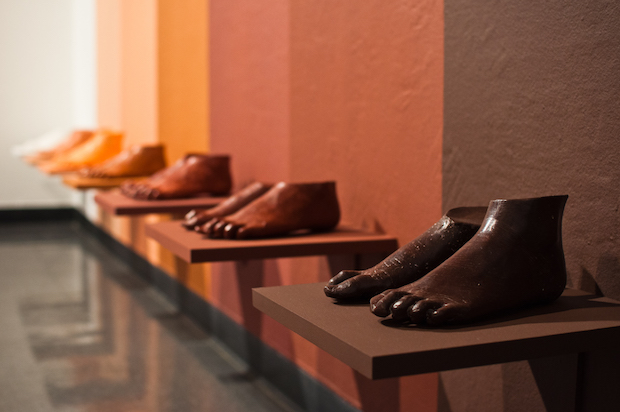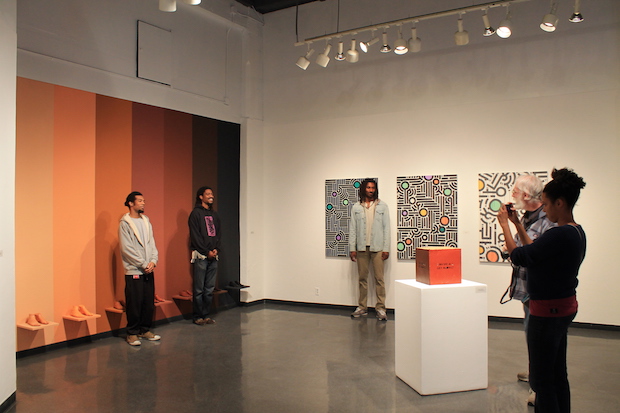
San Jose’s MACLA engages a multicultural community
Above: Multicultural Crayons, 2010, by Pilar Aguero Esparza. This article is cross-posted from Creative Exchange, the national program of Springboard for the Arts.
In early 2016, San Jose’s Movimiento de Arte y Cultura Latino Americana (MACLA) opened the exhibition “Custom Lives: Rasquache Renaissance.” The show exhibited colorful, cartoon-like sculptures of lowrider cars, shiny rims and mirrors displayed in patterns on the wall, and lowrider bicycles. The term “rasquache” has been used in Mexico in a derogatory way, meaning “discarded,” but it also refers to a Mexican-American aesthetic that is resourceful, eclectic, and personalized. “Custom Lives” was a celebration of that inventive customization.
“It’s looking at how lowrider cars are a form of creative expression that is just as valuable an art form as, say, a painting in a museum,” says Anjee Helstrup-Alvarez, MACLA’s Executive Director. “We’re trying to celebrate all forms of creative expression, both the vernacular as well as what we think of as art already.”
The show is just one example of how MACLA has explored Latin American identity and expression since it opened in 1989. The organization’s mission is to showcase and advance Latino and Chicano arts and culture in San Jose and the Bay Area. That includes working with artists who explore issues around immigration and the “hyphenated identity” of being between two cultures.

DMC Youth. Photo by David Sanchez.
This March, for example, MACLA hosted “’57 Chevy,” a one-man play written by Cris Franco and performed by Ric Salinas. The play takes place entirely in the backseat of the Chevy of the title, a symbol of the narrator’s family’s upward mobility as they move to the U.S. and then from South Central L.A. to the wealthier, whiter San Fernando Valley. “It’s the Latino Wonder Years,” says Helstrup-Alvarez.
MACLA wanted to be sure to invite audiences to “’57 Chevy” who would relate to the play, but who might not regularly go to the theater. They partnered with six local lowrider car clubs to organize a car show at MACLA leading up to the play, and worked with a designer to create a custom car air freshener as a promotional handout.
Strategies like those make art more accessible to everyone, says Helstrup-Alvarez, and that’s a key piece of MACLA’s mission.
“We have this conversation about making things popular and provocative,” she says. “We feel like [art] is such a critical, important piece of everyday life, but so many people have a tendency to say, ‘Oh, that’s not for me’ or ‘I’m not an artist’ — but they do things that are creative already, based on how they cut their hair or other forms of expression.”

DMC Studio Open House, South First Fridays, MACLA. Photo by Alexis Lobato.
In the past, MACLA was divided into specific program areas: visual art, literary art, performance, youth programs, and community arts. That’s not quite how they see it today, though, says Helstrup-Alvarez: Now, community engagement is at the core of all of MACLA’s work.
At a First Friday gallery walk, for instance, “People will not only see an amazing, say, Puerto Rican bomba group onstage, but they will be invited to learn how to do the dance as well,” says Helstrup-Alvarez. “It’s really that participatory, ‘We want you to come experience this with us.’”
“It’s about opening up the conversation, and allowing MACLA to be an intermediary between our community and the artistic content itself,” says Joey Reyes, who oversees MACLA’s programs as Curator of Engagement and Dialogue. “[Community engagement has] also changed the conversations that we’re having with artists coming in.”
As MACLA curates shows, he explains, they work with artists to find ways to invite interaction and dialogue.
One example is the 2015 exhibition “Found In Translation,” which featured the work of prolific San Jose artist Pilar Agüero-Esparza. Included in the show was a series of sculptures she had made of her daughter’s feet, cast in melted-down crayons from Crayola’s “multicultural” collection. Agüero-Esparza’s piece dealt with tension around race at the time: Crayola first released their set of skin tone-colored crayons in 1992, shortly after major riots in Los Angeles were triggered by the acquittal of police officers who had violently detained Rodney King.

Found in Translation exhibit, MACLA. Credit: Damian Kelly.
To encourage visitors to engage with the piece, Reyes worked with the artist to create a color chart based on the multicultural crayon set. Gallery patrons were invited to find the tone that matched their own skin and take a photo. That interaction encouraged people to think about the piece on a personal level, as it related to their own experience.
MACLA also worked to engage the community as part of “Around the Table,” a food-focused series of events, performances, and exhibitions at 60 sites around the community, led by the San Jose Museum of Art. Artist Robert Karimi created a performance piece at MACLA called “Love, Food, Love” — part theater piece, part participatory experience.
The show was “about the idea of communal cooking and eating as a revolutionary act,” explains Reyes. For a piece about food as the core of community, it was important to actually bring people together over a meal. Visitors were invited to join in collectively cooking three recipes: one for a Filipino dish, one Iranian, and one Guatemalan.
Besides the San Jose Museum of Art, MACLA frequently partners with other local arts organizations. They share a neighborhood — the South of First Area, or SoFA District — with the Museum of Quilts and Textiles and the San Jose Institute of Contemporary Art, and they often work with those institutions.
MACLA also looks for ways to partner with and support community organizations beyond the art sector, says Helstrup-Alvarez. Sometimes that’s as simple as offering their space up for meetings of neighborhood associations in the area; other times, they’re able to work together on a long-term creative project.
MACLA was an early supporter of San Jose’s first charter school, Downtown College Prep, whose mission is to prepare low-income, Latino students to apply to and attend college. Downtown College Prep was actually located at MACLA as it first launched, and they maintain a relationship that includes visits to the school from artists in residence, trips to events such as poetry slams, and involvement with MACLA’s youth programs.
Since 2011, MACLA has served young people through its Digital Media Center, dedicated to teaching 21st-century skills such as video and audio production. Before the DMC launched, the organization had a photography program that Helstrup-Alvarez describes as “low-tech”: They converted a bathroom into a darkroom for a program that encouraged neighborhood kids to document their lives and express themselves through photos.
Then an opportunity arose: MACLA is just a few blocks away from the headquarters of software company Adobe, which hoped to build a local laboratory for their Youth Voices program in 2011. Adobe partnered with the Black Eyed Peas’ Peapod Foundation — created by the Black Eyed Peas, of Fergie and Will.i.am fame — to create the media lab. The program, originally called the Peapod Adobe Youth Voices Academy, ultimately evolved into what is now known as the Digital Media Center. It allows young people to learn practical multimedia skills while expressing their perspectives on social, cultural, and personal issues.
MACLA’s goal is to make those resources available for young people who wouldn’t otherwise have access to them, including the region’s most vulnerable youth. The DMC partners with entities like the Santa Clara County Department of Family and Children’s Services and EMQ FamiliesFirst, a statewide nonprofit mental health treatment program, to provide opportunities to kids in foster care and in the juvenile justice system.
“That’s a really big thing with MACLA,” says Helstrup-Alvarez, “that no matter who you are and what your story is in life, our goal here for our youth is really to create a space where they feel safe, they feel welcomed, and that, frankly, people care.”
MACLA’s leaders also hope that the DMC can connect students to careers in the region’s thriving tech industry.
“Though we are here in Silicon Valley, because of issues of systemic oppression and racism, our kids don’t always see the tech corporations as a path for their future,” says Helstrup-Alvarez.
More and more tech companies are acknowledging their lack of diversity, she says. MACLA can play a small role in the industry’s shift: bringing groups of kids to corporations like Google, introducing them to professionals who might have a Spanish surname or an accent, and encouraging the kids to ask how those adults got where they are and what the journey was like.
“Trying to open our youth to a world of possibilities is what we do,” says Helstrup-Alvarez. “It’s not so much about our kids becoming artists — if that’s the route they choose, that’s fabulous — but it’s more about seeing themselves as a citizen of the world and as a citizen of this community, and that they have a menu of options and role models that they can call upon.”
The region’s largely tech-driven economic growth raises another issue for artists and arts nonprofits: affordable housing. In one of the country’s most expensive real-estate markets, it’s a major concern.
Though San Jose does have some housing set aside for artists and low-income residents, says Reyes, there’s not much of it — leading to worries that artists will be priced out of the area.
“Everything is an ecosystem,” says Helstrup-Alvarez. “It will be hard for us down the road to be a vibrant arts organization if we don’t have the vibrant artist community.”
Though affordable housing will continue to be a complex problem, MACLA is committed to supporting the region’s artists and helping them be successful in their careers.
That work is fueling MACLA’s involvement with the Leading Organizations pilot program, through which they share knowledge and resources with St. Paul’s Springboard for the Arts, Nashville’s Metro Arts, the Macon Arts Alliance, and the Greater Pittsburgh Arts Council. MACLA is creating case studies, based on their programs, that offer entrepreneurial advice for working artists.
The case studies focus on four major themes, explains Reyes: Navigating Cultures, How to Market Cross-Disciplinary Art Forms, Engaging Audiences, and Maintaining Meaningful Relevancy.
Because the case studies are rooted in MACLA’s programs, they tackle what it means to work as an artist across cultures, across languages, and within a multicultural community. MACLA’s work focuses on Latino and Chicano artists, and many of their patrons share those backgrounds, but it’s important for the organization to reach people of all ethnicities — for example, from the Bay Area’s large Vietnamese-American community.
“We don’t expect our audiences to be all Latino, because if they were, we wouldn’t be successful in our mission,” Helstrup-Alvarez says. “We want a broader public to come here, to feel welcome, to experience the amazing work that our artists are doing, and to really have a conversation that says, ‘What does it mean to live in this multicultural society today, and what might that look like from the perspective of Latino artists from various socioeconomic and national backgrounds?’”
The next big thing for MACLA: an outdoor gathering space that will allow them to bring together community members as they never have before. In partnership with the city of San Jose, MACLA received a National Endowment for the Arts Our Town grant to develop nearby Parque Plaza. Artist and architect Teddy Cruz is developing a flexible structure that will provide shade and allow the plaza to adapt to host performances, art fairs, and other events. Through the Our Town grant and working with Cruz, MACLA will be able to continue expanding its services for San Jose’s Latino community and beyond.
Recent Content
-
Community Impactarticle ·
-
Community Impactarticle ·
-
Community Impactarticle ·


